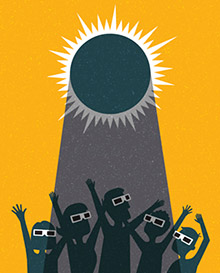
From about 2:38 to 2:41 p.m. on Monday, Aug. 21, the moon will cover 97.7 percent of the sun over Atlanta.
Science history will be made on Aug. 21, 2017, when a solar eclipse will be visible across North America. The entire continent will experience a partial eclipse for two to three hours. About halfway through the event, people within a path stretching from Oregon to South Carolina will briefly be able to see a total eclipse. Over that area, known as the path of totality, the moon will completely cover the face of the sun for almost three minutes.
During the time of total eclipse, the brightness of day changes to a deep twilight. The sun's outer atmosphere (the solar corona) gradually appears as the moon passes in front of the sun. The solar corona glows like a halo around the moon, making bright stars and planets more visible.
Having the opportunity to view a total solar eclipse is exciting, but it's important to remember that looking directly at the sun can cause serious damage to your eyes.
"Viewing a solar eclipse without the proper eye protection can permanently damage your retina and even cause blindness," says G. Baker Hubbard, III, MD, professor of ophthalmology at the Emory University School of Medicine and director of retina services at the Emory Eye Center. "This blindness, called solar retinopathy, is caused by the sun's UV radiation burning a blind spot near the center of your retina. The brain can't compensate for that and we don't have any type of treatment available today to correct it."
The only safe way to look directly at the sun – whether during a solar eclipse or on an ordinary day – is with proper eye protection.
Follow these tips from the Emory Eye Center's experts to view the solar eclipse safely.
- Look for glasses or viewers with special purpose solar filters. They must meet a specific, worldwide standard and are marked with the designation ISO 12312-2.
Keep in mind that homemade filters and regular sunglasses – even those with very dark lenses – are not safe for looking at the sun.
Examine your solar eclipse glasses or filter before using them. If you see any scratches or other type of damage, do not use them.
Always follow the manufacturer's directions on the solar glasses or filter. Practice with them a few times before the eclipse to ensure that you know how to use them correctly.
When preparing to look at the eclipse, look down and cover your eyes with your eclipse glasses or solar viewer. Glance at the sun (for no more than a few seconds), then look away and down before removing your glasses or filter.
Never look at the eclipse through an unfiltered camera, binoculars, telescope or similar devices. The solar rays coming through their lenses are intensified, and can cause serious damage to your eyes.
If you want to look at the solar eclipse through binoculars or a camera, cover the lens completely with an approved solar filter.
"It's important to follow these precautions with anyone, but especially with children," Dr. Hubbard says. "We don't normally look directly at the sun for long periods of time because it hurts our eyes. During a solar eclipse, the brightness is masked so it doesn't hurt to look. But the UV radiation we don't see can still cause permanent damage."
After the Aug. 2017 eclipse across North America, the next total solar eclipse will be in South America on July 2, 2019.
